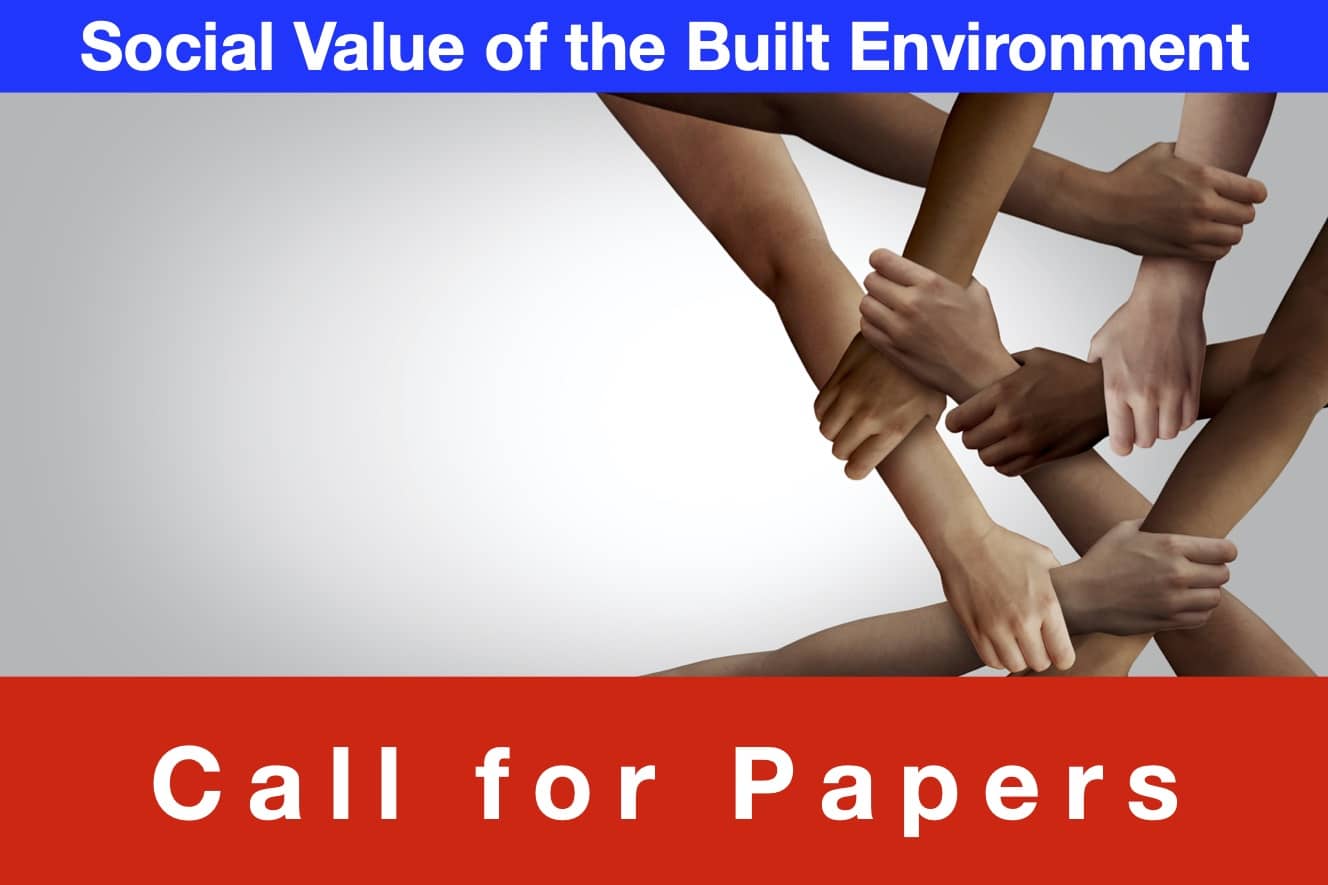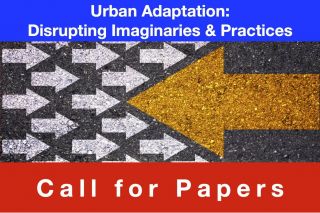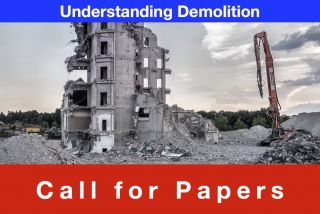
www.buildingsandcities.org/calls-for-papers/social-value-built-environment.html
Social Value of the Built Environment

Guest Editors: Flora Samuel (U of Reading) & Kelly J. Watson (Hatch Urban Solutions)
Abstract submissions closed on 1 NOVEMBER 2022
The UN Sustainable Development Goals define many values and actions for environmental, social, economic and climatic issues. Social value can be a driver to radically change built environment practices and outcomes. However, the questions surrounding the social value of the built environment - definitions, inclusion processes, delivery, evaluation and benefits - remain unclear and require further development by governments, industry, researchers and civil society. This special issue explores social value in relation to both placemaking (urban design, architecture and real estate) and construction (procurement and labour) processes.
The emergence of the social value agenda has real potential for the promotion of justice, equality and social cohesion in our built environment. Social value is often defined in different ways by sector, industry and context. A useful working definition is "the economic, social and environmental wellbeing of the relevant area" (PSSVA, 2012).
This working definition demonstrates an interrelationship with triple bottom line sustainability, as well as the importance of prioritising impact within a defined spatial area, which could be local, regional, national or wider. Other definitions emphasise the importance of stakeholders and beneficiaries recognising and placing a value on the changes they experience in their lives (Social Value UK, n.d.; Pearce, 2003; Johnston, 1992), as well as the quantification and measurement of positive impacts.
Aims
This special issue will explore current and potential approaches to defining, delivering, monitoring and evaluating social value in the built environment, its benefits and consequences and its relation to other existing policy mechanisms. How can planners, clients, designers create and evaluate social value at different scales? How can local stakeholders (communities) be involved and empowered? How can the intended outcomes be assured? Submissions are welcomed that examine these phenomena in the different social and economic contexts. Contributions that explore social value from various viewpoints and multiple perspectives are particularly welcome.
Context
That best value, or lowest cost, is an inadequate lens for describing success in policy terms is widely recognised (Raworth, 2017; Mazzucato, 2018). Economic, environmental and social value as triple bottom line accounting recognises the fallacy of financial and technical decision-making in isolation. While measures of economic value are widely agreed and environmental value is increasingly being mainstreamed through sophisticated tools and metrics relating to natural capital broadly, or more specific agendas of carbon and biodiversity, there is a need for consensus on how to ascribe, deliver and assess social value.
For the construction industry, social value has sometimes led to a focus on the delivery and procurement phases of development projects(e.g. Public Services (Social Value) Act (2012) imposing demands on public procurement). However, the long term opportunities are becoming recognised for maximising and localising socio-economic impact across the project lifecycle (Useful Projects, 2020), as well as embedding place-making, quality of life, wellbeing and lived experience evidence into planning, design and operational decision-making (Raiden & King, (2021).
Social value is growing in prominence. Approaches for the inclusion of social value in urban design and placemaking, cities, infrastructure and major operations are increasingly being prioritised. A recent industry initiative (UKGBC, 2021) for defining and delivering social value emphasises its context- and experience-specific nature as a mutable term co-created by stakeholders and local communities. There has been considerable work into the development of social value based cost benefit analyses (Watson and Whitley, 2016), with new emphasis on infrastructure and the historic environment (see for example Fujiwara et al., 2021). The adoption of social value could also change real estate practices, in particular around land valuation (Lorenz, Dent and Kauko, 2017).
Innovations in digital methods, participatory map-making with communities and other spatial analysis are beginning to enable a scaled up approach to bespoke social value creation and measurement, in a way that could disrupt previously unspatial assessment through approaches such as Social Return on Investment (SROI) (Stantec, 2022). This evolution can also be recognised in more recent procurement thinking, and the development of the Value Tool by the UK Construction Innovation Hub, a platform to facilitate the advance of outcomes- (or value-) based procurement.
Social value research often takes a siloed approach. Raiden et al. (2018) successfully drew together the work of a disparate group of social value researchers in construction procurement and management. Work on the social value of architecture and design was tackled by Samuel and Hatleskog (2020). There is now a strong need to bring together the fields of construction processes, physical artefacts and their ongoing use / management.
Suggested topics
The suggested topics for this special issue include, but are not limited to:
Planning for and delivering social value
- What approaches or processes can be used to establish what social value means in a particular context?
- How is social value of the built environment created from different types of projects, or by different organisations?
- How can top-down approaches to social value can be validated by bottom-up evidence?
- How different stakeholders perceive social value: differences between those responsible for delivering social value compared to those those lives it impacts upon.
Differences of perspective and lived experience relating to social value
- How do different cultures and demographics define and evaluate 'social value'?
- Understanding the variation of how social value is defined, measured, achieved or valued in different countries.
- Case studies from less economically developed regions.
- What processes can ascertain the distribution of social value within a given community, i.e. to those must vulnerable?
Opportunities, drivers, challenge and barriers for social value practice
- The relationship of social value to economic and environmental values
- The implications for operationalising social value within the planning system
- The potential opportunities and/or risks to investors and developers of embedding social value into their business models.
Holistic assessment of social value outcomes
- Encompassing a wide range of issues, e.g. employment, skills and local economy, quality of life and lived experience measures.
- How is this holistic view of value impacting on land use decision making, design, procurement and operation and management in the long term?
- What are the potential unintended consequences of trying to capture and evidence social value, in different sectors?
Systems for the measurement and evaluation of social value and quality of life
- The adaptation of post occupancy evaluation or other means.
- Ways in which social value in the built environment might align with the growing research agenda around capabilities.
Innovation in the use of digital technology
- The use of BIM or GIS for capturing social value value and quality of life.
- If social value is to be built into digital twin models of cities and places how can we ensure that the community voice is heard?
Policy mobilities
- The policy and industry backdrop to the terminology of value and quality of life.
- The different ways in which industry and academia treat topics like social value, i.e. middle range theory.
Briefing note for contributors
You are invited to submit an abstract for this special issue. Please send a 500 word (maximum) abstract to editor Richard Lorch richard@rlorch.net by 1 November 2022. Your submission must also include these 3 items:
- the author's and all co-author's names, institutional & departmental affiliations and contact details
- the question(s) in this Call for Papers that the abstract and intended paper address
- the abstract (300 - 500 words maximum) defining the research question(s), scope, methods and results
Abstracts will be reviewed by the editors to ensure a varied, yet integrated selection of papers around the topic. Authors of accepted abstracts will be invited to submit a full paper (6000-7500 words), which undergoes a double-blind review process.
Buildings & Cities is an international, open access, double-blind peer-reviewed research journal. Its focus is the interactions between buildings, neighbourhoods and cities by understanding their supporting social, economic and environmental systems. More information can be found online: www.buildingsandcities.org & published papers are found here: https://journal-buildingscities.org
Open access and Article Processing Charge
Buildings & Cities is an open access journal and has an article processing charge (APC) of £1200. If you do not have institutional support, please contact the editor when submitting your abstract. We endeavour to assist those without funding.
Questions?
If you have a
question, please contact:
Richard Lorch richard@rlorch.net,
Flora Samuel f.b.samuel@reading.ac.uk
or Kelly Watson kelly.watson@hatch.com
Timeline
|
Abstracts due |
01 November 2022 |
|
|
Full papers due |
06 March 2023 |
NB: authors can submit sooner if they wish) |
|
Referees' comments |
31 May 2023 |
|
|
Final version due |
July 2023 |
|
|
Publication |
October 2023 |
NB: papers are published as soon as they are accepted |
References
Fujiwara, D., Dass, D., King, E., Vriend, M., Houston, R. & Keohane, K. (2021). A framework for measuring social value in infrastructure and built environment projects: an industry perspectiv. Engineering Sustainability. https://doi.org/10.1680/jensu.21.00029
Johnston, C. (1992). What is social value? Canberra: Australian Heritage Commission. https://bit.ly/3vF2GsK
Lorenz, D., Dent, P. and Kauko, T. (eds) (2017). Value in a Changing Built Environment. London: Wiley.
Mazzucato, M. (2018). The Value of Everything: Making and Taking in the Global Economy. London: Allen Lane.
Pearce, D. (2003). The social and economic value of construction. London: Construction Industry Research and Innovation Strategy Panel.
PSSVA - Public Services (Social Value) Act (2012). https://www.legislation.gov.uk/ukpga/2012/3
Raiden A., Loosemore, M., King, A. & Gorse, C. (2018). Social Value in Construction. London: Routledge.
Raiden, A. and King, A. (2021). Social value, organisational learning, and sustainable development goals in the built environment. Resources, Conservation and Recycling, 172, 105663. https://doi.org/10.1016/j.resconrec.2021.105663.
Raworth, K. (2017). Doughnut Economics: Sevent Ways to Think Like a 21st Century Economist. London: Random House.
Samuel, F. and Hatleskog, E. (eds.) (2020). Special on Social Value. Architectural Design, 90(4). London: Wiley. https://onlinelibrary.wiley.com/toc/15542769/2020/90/4
Social Value UK. (n.d.). What is social value? https://socialvalueuk.org/what-is-social-value/
Stantec. (2022). Delivering better place outcomes through use of data. https://www.stantec.com/uk/projects/b/better-places-research-project
UK Green Building Council. (2021). Framework for Defining Social Value. London: UKGBC. https://bit.ly/3vGv911
Useful Projects. (2020) Maximising social value from infrastructure projects. Institution of Civil Engineers. https://bit.ly/3BHNIpI
Watson, K.J. and Whitley, T. (2016). Applying Social Return on Investment (SROI) to the built environment. Building Research & Information, 45(8), 875-891. https://doi.org/10.1080/09613218.2016.1223486.
Latest Peer-Reviewed Journal Content
Acceptability of sufficiency consumption policies by Finnish households
E Nuorivaara & S Ahvenharju
Key factors for revitalising heritage buildings through adaptive reuse
É Savoie, J P Sapinski & A-M Laroche
Cooler streets for a cycleable city: assessing policy alignment
C Tang & J Bush
Understanding the embodied carbon credentials of modern methods of construction
R O'Hegarty, A McCarthy, J O'Hagan, T Thanapornpakornsin, S Raffoul & O Kinnane
The changing typology of urban apartment buildings in Aurinkolahti
S Meriläinen & A Tervo
Embodied climate impacts in urban development: a neighbourhood case study
S Sjökvist, N Francart, M Balouktsi & H Birgisdottir
Environmental effects of urban wind energy harvesting: a review
I Tsionas, M laguno-Munitxa & A Stephan
Office environment and employee differences by company health management certification
S Arata, M Sugiuchi, T Ikaga, Y Shiraishi, T Hayashi, S Ando & S Kawakubo
Spatiotemporal evaluation of embodied carbon in urban residential development
I Talvitie, A Amiri & S Junnila
Energy sufficiency in buildings and cities: current research, future directions [editorial]
M Sahakian, T Fawcett & S Darby
Sufficiency, consumption patterns and limits: a survey of French households
J Bouillet & C Grandclément
Health inequalities and indoor environments: research challenges and priorities [editorial]
M Ucci & A Mavrogianni
Operationalising energy sufficiency for low-carbon built environments in urbanising India
A B Lall & G Sethi
Promoting practices of sufficiency: reprogramming resource-intensive material arrangements
T H Christensen, L K Aagaard, A K Juvik, C Samson & K Gram-Hanssen
Culture change in the UK construction industry: an anthropological perspective
I Tellam
Are people willing to share living space? Household preferences in Finland
E Ruokamo, E Kylkilahti, M Lettenmeier & A Toppinen
Towards urban LCA: examining densification alternatives for a residential neighbourhood
M Moisio, E Salmio, T Kaasalainen, S Huuhka, A Räsänen, J Lahdensivu, M Leppänen & P Kuula
A population-level framework to estimate unequal exposure to indoor heat and air pollution
R Cole, C H Simpson, L Ferguson, P Symonds, J Taylor, C Heaviside, P Murage, H L Macintyre, S Hajat, A Mavrogianni & M Davies
Finnish glazed balconies: residents' experience, wellbeing and use
L Jegard, R Castaño-Rosa, S Kilpeläinen & S Pelsmakers
Modelling Nigerian residential dwellings: bottom-up approach and scenario analysis
C C Nwagwu, S Akin & E G Hertwich
Mapping municipal land policies: applications of flexible zoning for densification
V Götze, J-D Gerber & M Jehling
Energy sufficiency and recognition justice: a study of household consumption
A Guilbert
Linking housing, socio-demographic, environmental and mental health data at scale
P Symonds, C H Simpson, G Petrou, L Ferguson, A Mavrogianni & M Davies
Measuring health inequities due to housing characteristics
K Govertsen & M Kane
Provide or prevent? Exploring sufficiency imaginaries within Danish systems of provision
L K Aagaard & T H Christensen
Imagining sufficiency through collective changes as satisfiers
O Moynat & M Sahakian
US urban land-use reform: a strategy for energy sufficiency
Z M Subin, J Lombardi, R Muralidharan, J Korn, J Malik, T Pullen, M Wei & T Hong
Mapping supply chains for energy retrofit
F Wade & Y Han
Operationalising building-related energy sufficiency measures in SMEs
I Fouiteh, J D Cabrera Santelices, A Susini & M K Patel
Promoting neighbourhood sharing: infrastructures of convenience and community
A Huber, H Heinrichs & M Jaeger-Erben
New insights into thermal comfort sufficiency in dwellings
G van Moeseke, D de Grave, A Anciaux, J Sobczak & G Wallenborn
'Rightsize': a housing design game for spatial and energy sufficiency
P Graham, P Nourian, E Warwick & M Gath-Morad
Implementing housing policies for a sufficient lifestyle
M Bagheri, L Roth, L Siebke, C Rohde & H-J Linke
The jobs of climate adaptation
T Denham, L Rickards & O Ajulo
Structural barriers to sufficiency: the contribution of research on elites
M Koch, K Emilsson, J Lee & H Johansson
Disrupting the imaginaries of urban action to deliver just adaptation [editorial]
V Castán-Broto, M Olazabal & G Ziervogel
Nature for resilience reconfigured: global- to-local translation of frames in Africa
K Rochell, H Bulkeley & H Runhaar
How hegemonic discourses of sustainability influence urban climate action
V Castán Broto, L Westman & P Huang
Fabric first: is it still the right approach?
N Eyre, T Fawcett, M Topouzi, G Killip, T Oreszczyn, K Jenkinson & J Rosenow
Social value of the built environment [editorial]
F Samuel & K Watson
Understanding demolition [editorial]
S Huuhka
Data politics in the built environment [editorial]
A Karvonen & T Hargreaves



Latest Commentaries
Decolonising Cities: The Role of Street Naming
During colonialisation, street names were drawn from historical and societal contexts of the colonisers. Street nomenclature deployed by colonial administrators has a role in legitimising historical narratives and decentring local languages, cultures and heritage. Buyana Kareem examines street renaming as an important element of decolonisation.
Integrating Nature into Cities
Increasing vegetation and green and blue spaces in cities can support both climate change mitigation and adaptation goals, while also enhancing biodiversity and ecological health. Maibritt Pedersen Zari (Auckland University of Technology) explains why nature-based solutions (NbS) must be a vital part of urban planning and design.